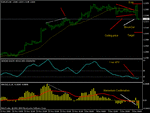FX_Cowboy
Well-known member
- Messages
- 250
- Likes
- 16
A couple of additional thoughts on the contract strategies. C1 can be traded as a standalone scalp entry, or else as a way to get the overall (multiple contract) trade to BE, which was the original intention. I think the C1 strategy makes sense, is fairly straightforward, and with a bit more flexibility in real time, should perform at least as well in forward testing, paper trading and actual trading as in backtesting.
The C2 and C3 strategies need to be more focused and better defined. C2's current job is to run from trade entry to a predefined target, which at the moment is a fairly distant S/R level that I seem to be identifying using different criteria at different times, but which in general is based on previous price movements and where S/R have shown up in the past. And this is where I'm running into some problems in forward testing. In backtesting, it's easy to set targets that will be hit, and to rationalize how one might be setting those same targets in real time. But I've seen that setting targets based on historical levels ONLY leads to a disconnection from what is happening in the market, and is less reliable than I had hoped. That may be due solely to my own personal limitations, but there it is. In addition, I have C2 taking on C3 rules at certain times, which complicates the situation further.
The rules for C3 are based on the idea that C3 is a "runner" -- the contract remains open until there is some reason to close it. That idea in itself sounds fine, but my implementation of the idea, again, has been anchored on predefined S/R levels. On days when price action is range-bound -- or simply doesn't conform to my preconceived S/R levels -- the C3 strategy gets hammered.
These are some problems I'm going to have to deal with. I have some ideas on possible steps to improve the situation, which I'll detail in a later posting.
The C2 and C3 strategies need to be more focused and better defined. C2's current job is to run from trade entry to a predefined target, which at the moment is a fairly distant S/R level that I seem to be identifying using different criteria at different times, but which in general is based on previous price movements and where S/R have shown up in the past. And this is where I'm running into some problems in forward testing. In backtesting, it's easy to set targets that will be hit, and to rationalize how one might be setting those same targets in real time. But I've seen that setting targets based on historical levels ONLY leads to a disconnection from what is happening in the market, and is less reliable than I had hoped. That may be due solely to my own personal limitations, but there it is. In addition, I have C2 taking on C3 rules at certain times, which complicates the situation further.
The rules for C3 are based on the idea that C3 is a "runner" -- the contract remains open until there is some reason to close it. That idea in itself sounds fine, but my implementation of the idea, again, has been anchored on predefined S/R levels. On days when price action is range-bound -- or simply doesn't conform to my preconceived S/R levels -- the C3 strategy gets hammered.
These are some problems I'm going to have to deal with. I have some ideas on possible steps to improve the situation, which I'll detail in a later posting.

